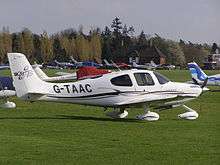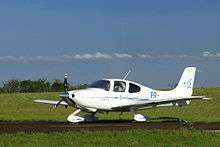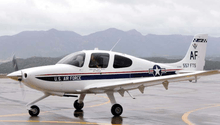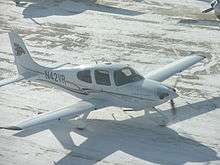Cirrus SR20
| SR20 | |
|---|---|
 | |
| Role | Civil utility aircraft |
| Manufacturer | Cirrus Aircraft |
| First flight | 21 March 1995 |
| Introduction | 1994[1] |
| Produced | 1999–Present |
| Unit cost |
US$369,900 (Base price, 2016)[2] |
| Variants | Cirrus SR22 |
The Cirrus SR20 is an American piston-engine, four-or-five-seat, composite monoplane built by Cirrus Aircraft of Duluth, Minnesota.
The SR20 was the first production general aviation aircraft equipped with a parachute to lower the airplane safely to the ground after a loss of control, structural failure or mid-air collision. It was also the first manufactured light aircraft with all-composite construction and flat-panel avionics.[3][4]
Design and development


The SR20 was first flown on 21 March 1995.[5] FAA certification was achieved on 23 October 1998.[6] At the time of the airplane's release, the general aviation industry was struggling; the SR20 was one of the first of its kind to earn FAA Part 23 certification in several years.[7] Over a thousand SR20s have been sold since deliveries began in 1999. As of June 2015, more than 6,000 Cirrus aircraft had been delivered,[8] something that no other aviation company has done for decades.[9]
One of the major selling points for the SR20 is its Cirrus Perspective avionics suite (by Garmin) with dual 10-inch (250 mm) or 12-inch (300 mm) screens: one primary flight display (PFD) and one multi-function display (MFD). This provides all standard communication, navigation (GPS and conventional VHF), and surveillance (Mode S transponder) functions. Other avionics features include in-flight weather information and TCAS-like traffic information.
SR20s made from 1999 to 2003 were equipped with traditional analog instruments and a 10" MFD. In July 2003, Cirrus made PFDs standard on their SR-series, pioneering the use of glass cockpits in the light aircraft general aviation industry.[10]
The airplane remains the only of its kind to include side stick flight controls that combine aspects of a traditional yoke handle (this has been referred to in the industry as a "side yoke").[4]
The SR20, like the faster SR22, is equipped with the Cirrus Airframe Parachute System, a large parachute that can be deployed in an emergency to lower the entire aircraft to the ground safely.[6] As of 2015, the SR-series has deployed the system 53 times carrying 107 survivors.[11]
On 1 June 2004, the SR20 became the first aircraft to achieve the new European Aviation Safety Agency certificate for aircraft imported into the European Union.
In 2004, Cirrus introduced the SR20 G2 (Generation 2) and in 2008 the SR20 G3 (Generation 3). Both were defined by airframe modifications, G2 by fuselage and G3 by wing/landing gear changes. Since 2011, simply "SR20" has been used.
In 2012, "60/40 flex seating" was introduced, allowing up to three passengers in the rear with a split fold-down seat arrangement. This five-seat configuration was optional in 2012 but became standard equipment for 2013 SR20 models.[12]
In 2016, Cirrus introduced enhancements to the SR Series, including Bluetooth wireless connectivity, a remote keyless entry, convenience lighting system, and a new easy access door latch, among other interior and exterior improvements.[13][14]
Variants
SR20 G2

Improved variant introduced in 2004.
SR20 G3
In 2007, Cirrus introduced an updated model of the SR20 that incorporates changes from the SR22 G3 airframe, including installing a lighter, larger SR22-length wing. The new wing increased the SR20's cruise speed by 6–7 knots (11–13 km/h).[15] This improved model is called the SR20 G3 for "Generation 3". The new model includes:[16]
- A lighter wing of greater area, incorporating a carbon-fiber spar[17]
- Increased useful load by 50 pounds (23 kg) by increasing the take-off weight to 3,050 pounds (1,380 kg)
- Re-designed main landing gear that is 2 inches (5 cm) taller giving greater propeller and tail clearance
- New recognition lights using LEDs
- Improved aircraft handling, due to increased dihedral
- Improved aerodynamics, including new wing root fairings
- Improved heat and ventilation
- Dual-redundant GPS WAAS-certified Garmin GNS 430W comm-navigators (they include a VHF radio and a VOR/LOC/ILS receiver)
- S-Tec Autopilot
SRV
The Cirrus SRV was a VFR-only version of the SR20 for the low-end private ownership and flight training market. As such it omitted some standard equipment available on the SR20 such as wheel fairings.[18] For 2008 the SRV model was updated to G3 configuration, with the SR22 wing.[19] Cirrus discontinued the SRV for the 2010 model year.
T-53A

In 2011, the SR20 was selected for cadet flight training with the 306th Flying Training Group at the United States Air Force Academy and given an Air Force model/design/series (MDS) designation as the T-53A. Twenty-five examples will be purchased to replace the Academy's current stock of 20 leased T-52As by May 2012.[20][21]
Operators
Civil

The SR20 is popular with many flying schools and is operated by private individuals and companies. The largest operators are CAFUC (Civil Aviation Flight University of China) operating 40 aircraft, Aerosim Flight Academy which operates 34, Western Michigan University which has 26 and Purdue University with a fleet of 16.[22][23][24]
Military
- French Air Force and French Navy Academies (operated by Cassidian) - 23 aircraft (mixed fleet of 16 SR20s and 7 SR22s).[25]
- United States Air Force Academy - 25 T-53A aircraft (version of SR20)[26]
Accidents
On March 23, 1999, Duluth native Scott D. Anderson was killed in a plane crash while flight-testing the first production-model SR20 before it went on sale. Anderson was a pilot, author, engineer and adventurer who served as Chief Test Pilot at Cirrus in the mid- to late-1990s, performing all the inflight test-deployments of the Cirrus Airframe Parachute System (CAPS). His plane, which had not yet been equipped with CAPS, experienced an aileron jam during experimental stress-testing and went down in a field on the prison grounds about 400 meters from the Duluth International Airport. Anderson was inducted into the Minnesota Aviation Hall of Fame in 2010 and is often praised as a hero by the local community.[27][28][29][30]
New York Yankees pitcher Cory Lidle and certified flight instructor Tyler Stanger were killed in the 2006 New York City plane crash on October 11, 2006, when their SR20 crashed into the Belaire Apartments in New York City. The aircraft struck the north side of the building, located on the Upper East Side of Manhattan, causing a fire in several apartments. The accident was the result of high winds and pilot error.[31][32][33][34][35]
In 2011, the accident record of the SR20 and -22 was the subject of a detailed examination by Aviation Consumer magazine. The review concluded that the series has an overall accident record that is better than average for light aircraft, exceeded only by the Diamond DA40 and DA42. However, its fatal accident rate is much worse at 1.6/100,000 hours, placing it higher than the U.S. general aviation rate of 1.2 and higher than the Diamond DA40 (.35), Cessna 172 (.45), Diamond DA42 (.54), Cessna 182 (.69) and the Cessna 400 (1.0), despite the Cirrus's full aircraft parachute system.[36]
By 2014, the accident rate had been dramatically reduced, with a 2013 fatal rate of 1.01 per 100,000 flight hours. This was attributed to better training, particularly in when to deploy the ballistic parachute system.[37]
By 2015, the accident rate had continued to decrease, with a 2014 fatal rate of .42 per 100,000 flight hours, making it one of the best safety records in the industry. This marked the fewest fatalities in a single year for Cirrus since 2001, and the first year where the number of CAPS deployments (12) exceeded the number of fatal accidents (3).[38][39][40]
Between 1999 and 2015 the SR20 was involved in 27 known fatal accidents.[41]
Specifications (SR20-G3)
Data from Cirrus SR20 Specifications Webpage[19]
General characteristics
- Length: 26 ft 0 in (7.92 m)
- Wingspan: 38 ft 4 in (11.68 m)
- Height: 8 ft 11 in (2.72 m)
- Empty weight: 2,126 lb (964 kg)
- Gross weight: 3,050 lb (1,383 kg)
- Powerplant: 1 × Continental IO-360-ES six cylinder, horizontally-opposed piston aircraft engine, 200 hp (150 kW)
- Propellers: 3-bladed
Performance
- Cruise speed: 155 kn (178 mph; 287 km/h) TAS
- Stall speed: 56 kn (64 mph; 104 km/h) CAS
- Service ceiling: 17,500 ft (5,300 m)
- Rate of climb: 828 ft/min (4.21 m/s)
Avionics
- Garmin Cirrus Perspective glass cockpit
- GMA 350 All-digital Audio Panel
- Dual WAAS GPS/Comm/Nav Radios
- Garmin GFC700 Autopilot with Electronic Stability and Protection
- Dual attitude and heading reference system
- 406 MHZ ELT
- ADS-B transponder
See also
- Related development
- Aircraft of comparable role, configuration and era
References
- ↑ CompsitesWorld (2010). "Cirrus Aircraft's SR22 second-generation design improves functionality and enables faster processing". Retrieved 2015-08-31.
- ↑ Cirrus Aircraft (2015). "SR20 USA Price List" (PDF). Retrieved 12 February 2016.
- ↑ "Top 100 Airplanes:Platinum Edition". Flying. Retrieved 2014-11-08.
- 1 2 Robert Goyer (2011). "10 Ways that the SR22 Changed Flying".
- ↑ Aerofiles: Aircraft Ca to Ci Retrieved 24 July 2011.
- 1 2 Federal Aviation Administration (May 2008). "TYPE CERTIFICATE DATA SHEET NO. A00009CH Revision 13" (PDF). Retrieved 2008-10-14.
- ↑ Goyer, Robert (Sep 2008). "Cirrus SR20 G3". Retrieved July 10, 2015.
- ↑ Cirrus Aircraft News (June 15, 2015). "Cirrus Aircraft Celebrates 6,000th Airplane Delivery". Retrieved June 16, 2015.
- ↑ Davison, Budd (December 14, 2015). "Aviation 1965-2015". Retrieved January 5, 2016.
- ↑ National Transportation Safety Board. "Introduction of Glass Cockpit Avionics into Light Aircraft" (PDF). Retrieved 2015-09-11.
- ↑ Cirrus Owners and Pilots Association (16 August 2015). "Cirrus CAPS History". Retrieved 12 September 2015.
- ↑ "Cirrus Aircraft". Cirrus Aircraft. Retrieved 2013-05-29.
- ↑ "Cirrus Aircraft 2016 SR Series Introduction". Vimeo.com. January 2016. Retrieved June 10, 2016.
- ↑ Cirrus Aircraft News (February 16, 2016). "Cirrus Aircraft Unveils Enhanced 2016 SR Series". Retrieved June 10, 2016.
- ↑ Niles, Russ F. (April 2008). "G3 SR20 Has New Wings, Refined Interior". Retrieved 2008-04-14.
- ↑ Cirrus Design (2007). "Cirrus SR20 What's New". Retrieved 2007-12-27.
- ↑ Flying Magazine: 20. February 2008. Missing or empty
|title=(help) - ↑ Cirrus Design. "Cirrus SR20 Models". Retrieved 2007-12-27.
- 1 2 Cirrus Aircraft (2016). "SR20 Specifications". Retrieved 5 January 2016.
- ↑ Associated Press (June 2011). "Academy gets 25 new trainer aircraft for $6.1M". Air Force Times. Retrieved 17 June 2011.
- ↑ "EAA News - USAF Academy Buys Cirrus SR-20s, Designates T-53A". Eaa.org. 2011-07-06. Archived from the original on 2012-10-25. Retrieved 2012-10-11.
- ↑ Rachel (July 2008). "Delta connection academy offers high school students discovery flights in partnership with a nationwide ace camp program". Retrieved 2009-06-11.
- ↑ Western Michigan University College of Aviation. "Aircraft - Cirrus SR-20". Retrieved 28 March 2011.
- ↑ "Purdue Acquires Cirrus Aircraft". January 2010. Archived from the original on May 14, 2010. Retrieved 2010-02-11.
- ↑ "Cirrus News: French Air Force/Cassidian". Retrieved 2013-05-29.
- ↑ "Cirrus News: Final Air Force T-53A Deliveries". Retrieved 2013-05-29.
- ↑ Passie, Peter (April 2010). "Pilot Scott Anderson Remembered". Retrieved 30 January 2015.
- ↑ Fallows, James (November 21, 1999). "Turn Left at Cloud 109". The New York Times. Retrieved 2015-01-30.
- ↑ Fallows, James (March 7, 2007). "Lidle lawsuit update: the myth of 'aileron failure'". The Atlantic. Retrieved 2015-01-30.
- ↑ Higdon, Dave (March 31, 1999). "Cirrus SR20 demonstrator kills test pilot in prison crash". Flighglobal. Retrieved 2015-01-30.
- ↑ "Yankee Pitcher Dies as Plane Crashes Into NYC High-Rise". ABC News. October 11, 2006. Retrieved May 8, 2009.
- ↑ "Yankees pitcher killed in crash of small plane in Manhattan". CNN. October 12, 2006. Archived from the original on April 15, 2009. Retrieved May 8, 2009.
- ↑ "Yankees Player Among Two Killed In Small Plane Crash On Manhattan's UES". NY1. October 11, 2006. Archived from the original on September 27, 2007. Retrieved May 8, 2009.
- ↑ Feinsand, Mark (October 11, 2006). "Yankees' Lidle killed in plane crash". MLB.com. Retrieved May 8, 2009.
- ↑ Yaniv, Oren; Leo Standora (October 12, 2006). "2nd victim died living his dream". Daily News. New York. Archived from the original on October 29, 2006. Retrieved May 8, 2009.
- ↑ AVweb staff (20 December 2011). "Aviation Consumer: Cirrus Safety Record Just Average". AVweb. Retrieved 22 December 2011.
- ↑ Bertorelli, Paul (10 April 2014). "Cirrus Reports Dramatic Accident Reduction". Avweb. Retrieved 14 April 2014.
- ↑ Zimmerman, John (11 February 2015). "Fatal Cirrus crashes are way down – thank the parachute". Air Facts. Retrieved 11 June 2015.
- ↑ Beach, Rick (1 July 2014). "Mid-Year 2014 Update on Improved Cirrus accident rates". Cirrus Owners and Pilots Association. Retrieved 11 June 2015.
- ↑ Anders, Clark (22 May 2015). "Cirrus SR22: The Plane with the Parachute". Disciples of Flight. Retrieved 11 June 2015.
- ↑ "ASN Aviation Safety Database results SR20". Retrieved 4 January 2016.
External links
| Wikimedia Commons has media related to Cirrus SR20. |